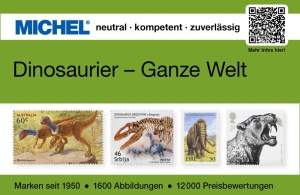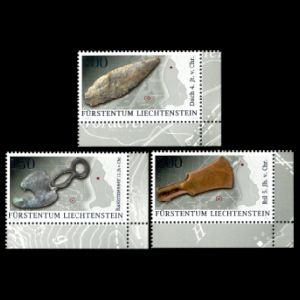the place where Paleontology and Paleoanthropology meets Philately
Liechtenstein
Fossils, dinosaurs and flint tool on official and personalized stamps of Liechtenstein
| << previous country | back to index | next country >> |
Contents:
- Country overview
- Philately of Liechtenstein
- Official stamps of Liechtenstein related to Paleontology
- Some personalized stamps of Liechtenstein related to Paleontology
- References
- Acknowledgements
Liechtenstein, officially the Principality of Liechtenstein, is a doubly landlocked German-speaking microstate in Central Europe. It is a constitutional monarchy with the rank of principality, headed by the Prince of Liechtenstein. Liechtenstein is bordered by Switzerland to the west and south and Austria to the east and north.
It has an area of just over 160 square kilometres and an estimated population of 37,000. Divided into 11 municipalities, its capital is Vaduz and its largest municipality is Schaan.
The country has a strong financial sector centered in Vaduz. Liechtenstein is a member of the European Free Trade Association, and while not being a member of the European Union, the country participates in both the Schengen Area and European Economic Area. It also has a customs union and a monetary union with Switzerland [R1]
Austrian stamps were valid in Liechtenstein until 31 January 1921. The first stamps of the Principality of Liechtenstein were issued in 1912. [R2]
Official stamps of Liechtenstein related to Paleontology: fossils
| 02.06.2003 "Reopening of the national museum" [1] | 22.11.2004 "Fossils" | |
 |
 |

|
Notes:
[1] Ammonite fossil shown on stamp with face value 1.20F.
Some personalized stamps of Liechtenstein related to Paleontology: dinosaurs, petrified wood
| 06.02.2020 "Stegosaurs" [SP1] | 30.09.2021 "Dendrolith" [SP2] | |
 |
 |
|
Notes:
[SP1] This stamp was produced and sold by a German philatelic dealer.
Stegosaurus with integrated gem stone of epidosite. Epidosite is a metamorphic rock made of quartz and epidote. The gemstone is in the shape of a dinosaur egg.
As the stone is embedded in the stamp, it was impossible to produce a good scan of the stamp. After several trials, I just photographed it with my smart phone. The stamp is delivered in a plastic box to keep the stone and stamp safe.
[SP2] Personalized stamp of Liechtenstein, produced by a German philatelic dealer, with real piece of petrified wood on the top-right corner.
DENDROLITH is just another word for petrified wood.
Other stamps to consider: flint tool
| 09.03.2016 "Archaeological finds in Liechtenstein: Utensils" [A1] | ||
 |
|
|
Notes:
[A1] The dagger, stamp with face value of 100, was made of flint, "prehistoric man’s steel", in the Neolithic period (12.000 years ago -6.000 years ago). Experts assume that it was imported from Monti Lessini at Lake Garda by people belonging to the Horgen culture who lived on the Schellenberg-Borscht site. The lancet-shaped blade which has a broken-off tip is eleven centimetres long and the organic handle is missing. The dagger is important evidence of the trade relations that were conducted over long distances by the Neolithic inhabitants of the Alpine Rhine Valley. [R3]
References:
- [R1] Liechtenstein:
Wikipedia,
WikiTravel,
FlagCounter.
- [R2] Postal History and Philately of Liechtenstein:
Wikipedia,
Links to official website of the Post Authority, stamp catalog and a list of new stamps of Liechtenstein are here - [R3] Archaeological finds in Liechtenstein: Utensils: Official press release
Acknowledgements:
Many thanks to Dr. Peter Voice from Department of Geological and Environmental Sciences, Western Michigan University, for the draft page review and his valuable comments.
| << previous country | back to index | next country >> |